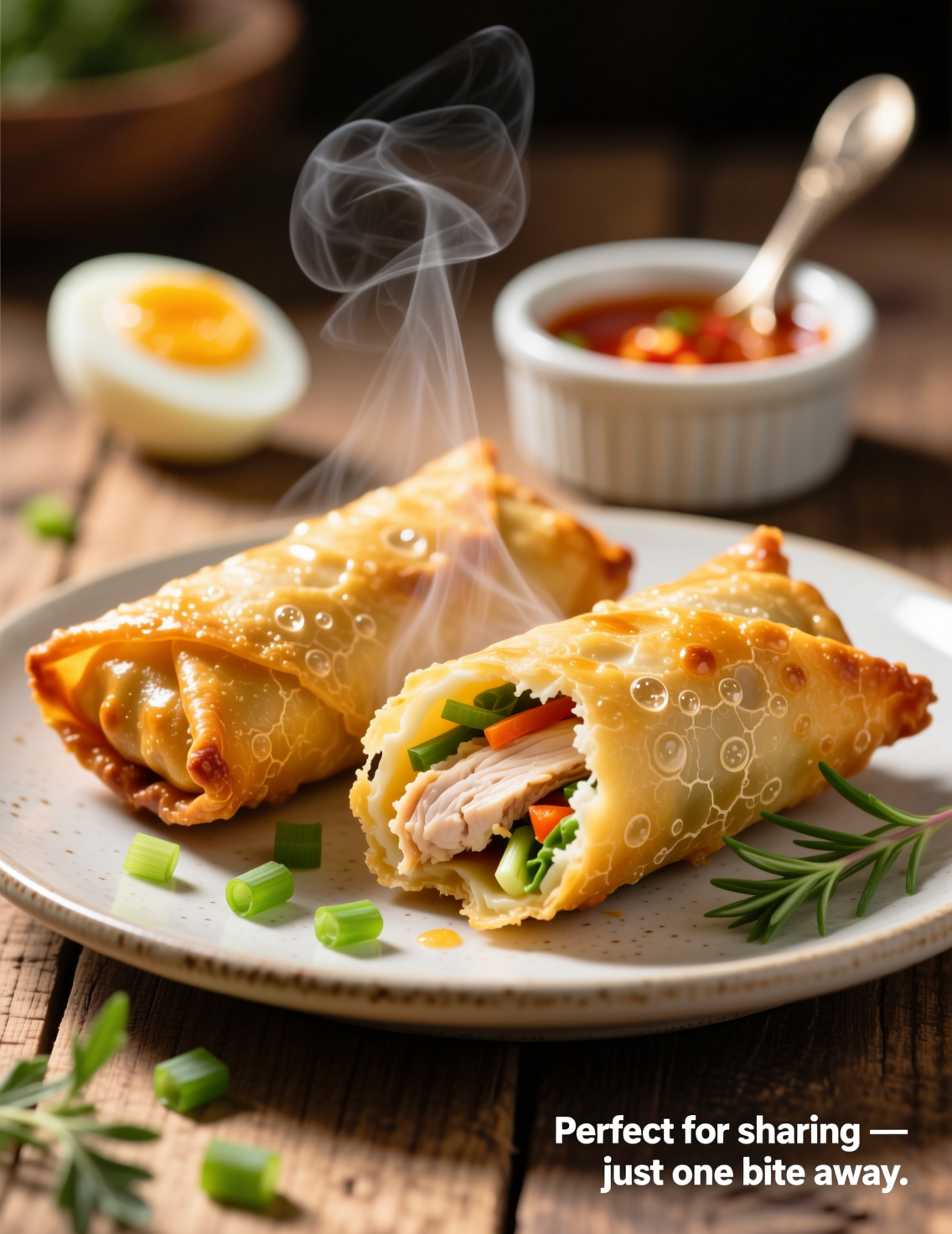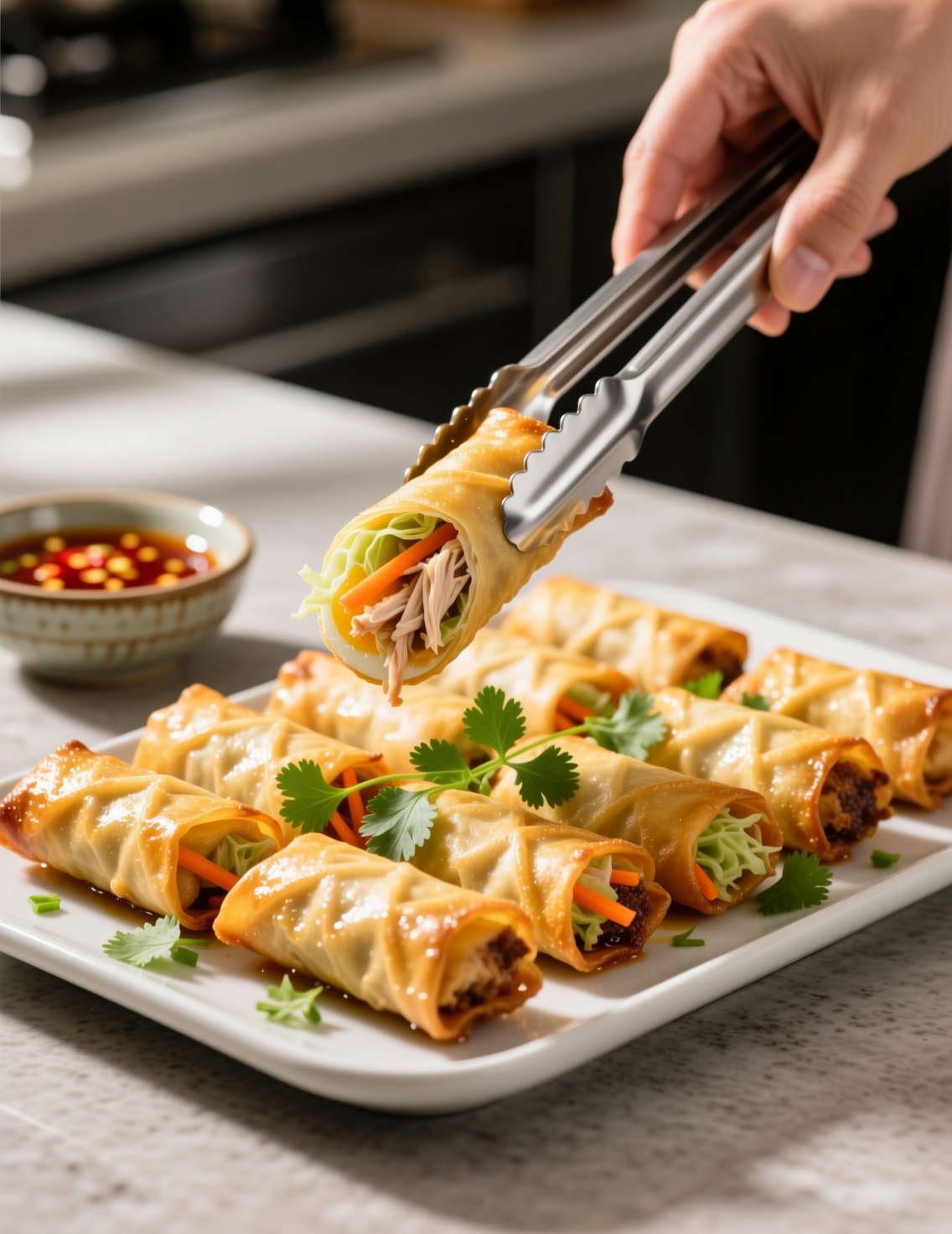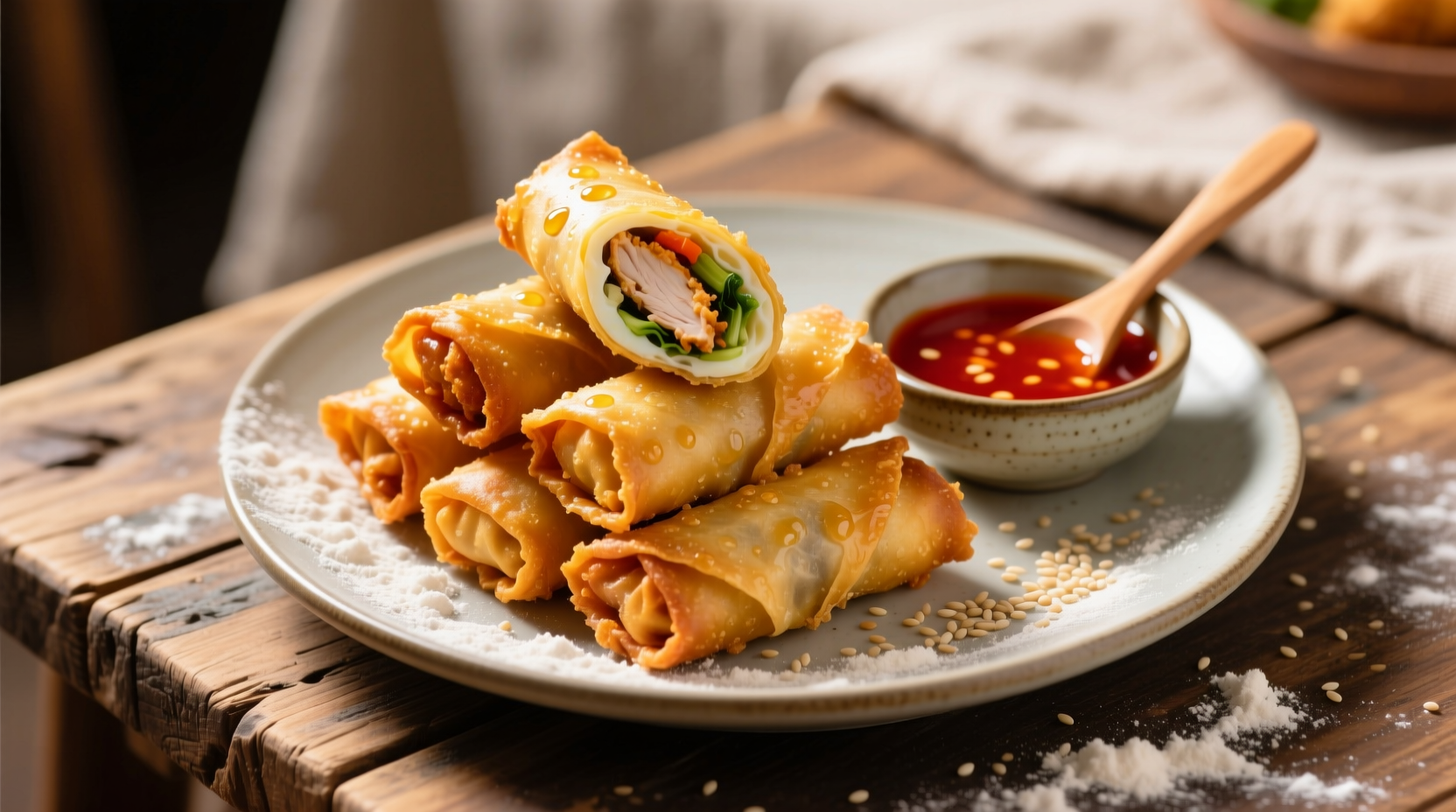When you bite into a perfectly made chicken egg roll, the crunch hits first. Then comes the tender filling, rich with chicken, vegetables, and seasoning that work like an orchestra in your mouth. This recipe for crispy chicken egg rolls—scaled for 20 servings—isn’t just a casual snack recipe; it’s a blueprint that professional chefs, caterers, and serious cooks can lean on when consistency and quality matter.
Why Chicken Egg Rolls Deserve Professional Attention
Egg rolls might look simple, but making them for 20 people isn’t as straightforward as tossing some chicken in a wrapper. In large-batch cooking, the slightest slip—like overloading filling or letting moisture seep—can collapse texture completely. According to a 2022 report by the National Restaurant Association, appetizers like egg rolls remain among the top-selling small bites in American casual dining, accounting for a significant chunk of repeat orders. Customers remember the crunch. They notice soggy ones, too.
Caterers often say finger foods like these decide whether guests keep nibbling or leave plates untouched. For professionals, that’s reputation on the line. That’s why details—oil temperature, moisture control, wrap technique—aren’t side notes, they’re central.
Ingredients at Scale for 20 Servings
The math has to be right. Professionals hate “eyeballing” when it comes to big batches because one off-ratio can ruin texture. Here’s a balanced breakdown for 20 crispy chicken egg rolls:
- 3 pounds ground chicken (lean, 90/10 works best)
- 6 cups shredded cabbage (green, tight leaves, not too wet)
- 3 cups shredded carrots (fine julienne holds texture)
- 1 ½ cups chopped green onions
- 3 tablespoons fresh garlic, minced
- 2 tablespoons fresh ginger, grated
- 6 tablespoons soy sauce (low sodium keeps balance)
- 2 tablespoons sesame oil
- 2 teaspoons black pepper
- 20 egg roll wrappers (square, about 6×6 inch each)
- 1 beaten egg (for sealing)
- Vegetable oil for frying (about 8 cups depending on fryer size)
Scaling isn’t just about multiplying. It’s about maintaining moisture and oil balance. Too many wet vegetables and wrappers burst. Too much chicken, and you lose that airy crunch that defines a good egg roll.

Step-By-Step Professional Method
Preparing the Filling
Cook the ground chicken in a wide sauté pan. Wide is important; it prevents steaming and ensures caramelization. Add garlic and ginger once chicken loses pink. Stir briskly, but don’t overwork—tough chicken ruins everything.
Drain excess fat immediately. Then fold in cabbage, carrots, and scallions. Let them just soften, not wilt into mush. Professionals stop the heat right here, because carry-over cooking will finish the vegetables. Add soy, sesame oil, and pepper. Cool completely before rolling. Warm filling will steam wrappers and split seams.
Rolling with Precision
Lay out wrappers on a clean board. Add about 3 tablespoons filling diagonally across each wrapper. Tuck the bottom over filling, fold sides inward, then roll tight to tip. Brush edge with beaten egg to seal. Professionals often double-seal edges for catering, because no one wants a rogue burst in hot oil.
Frying for Maximum Crunch
Heat oil to 350°F. No guessing—use a thermometer. Slide in rolls gently, never overcrowding, because that plummets oil temp and makes soggy rolls. Fry 3–4 minutes until golden brown. The sound of frying should be consistent, not angry spitting. That means oil temp is stable. Drain on a rack, not paper towels. Racks preserve crunch; towels steam it away.
Common Mistakes and Professional Fixes
Many home cooks complain egg rolls split while frying. That’s moisture control, plain and simple. Filling must be cooled and wrappers sealed tight. Some chefs even dust filling lightly with cornstarch to absorb extra liquid.
Another misstep? Wrappers absorbing oil. This happens when oil temp is too low. In commercial kitchens, staff are trained to let oil recover between batches—patience is the secret. One batch too soon and you’re serving greasy rolls no one eats twice.
Scaling for Catering and Service
Serving 20 isn’t the same as frying 20 in one go. Smart caterers batch-fry in sets of 5–6 and hold rolls in a low oven at 200°F for up to 30 minutes. The crunch surprisingly survives if rolls are drained properly.
For larger events, par-frying is common. Fry until lightly golden, chill quickly on racks, then refry for 1–2 minutes before serving. This two-step fry technique ensures consistent texture without last-minute chaos. According to catering surveys, 68% of chefs use par-frying for high-volume finger foods like egg rolls, fries, and samosas.
Variations That Work in Professional Kitchens
While chicken egg rolls are classic, professionals often customize fillings for seasonality and audience. Swap cabbage for finely shredded Brussels sprouts in fall, or add water chestnuts for extra crunch. A growing trend in 2025? Protein blends. Some chefs mix chicken with shrimp or even plant-based crumbles to meet dietary demands.
Spice adjustments also matter. A touch of chili garlic sauce mixed into the filling brings heat without overpowering. In fine dining settings, I’ve even seen truffle oil replacing sesame for a luxurious twist. The key is balance. The wrapper is delicate, so heavy, wet fillings don’t belong here.
Pairing and Presentation Insights
Presentation sells just as much as flavor. Rolls should always be cut on the bias for service—angled halves display filling and catch the eye. Serve with small ramekins of dipping sauces: sweet chili, soy-vinegar, or spicy peanut.
From a professional standpoint, dips must complement, not drown. For instance, serving heavy hoisin next to delicate chicken egg rolls masks flavor. Better to offer something light and bright. Some chefs add pickled vegetables on the side to cut the richness, an idea borrowed from Vietnamese banh mi service style.

Nutritional and Cost Analysis
Professionals can’t ignore cost-per-serving, especially when scaling for 20 or more. This recipe, using chicken, averages around $0.85–$1.00 per roll depending on region and supplier. Compare that to shrimp rolls at nearly $1.60–$1.80 each, and chicken clearly dominates catering menus.
Nutritionally, one roll averages 150–170 calories, 7g protein, and about 8g fat. Not exactly diet food, but portion-controlled appetizers like these tend to fit within catering menus easily.
Addressing Misconceptions
A common misconception is that baking egg rolls can achieve the same crispness as frying. While oven-baked rolls may save calories, they lack the signature blistered texture. Air-frying comes closer but still struggles with even browning. Professionals know deep frying, when done right, isn’t greasy—it’s science. Oil seals instantly at the right temperature, locking moisture inside.
Another misconception is pre-wrapping rolls hours ahead. In truth, wrappers dry out fast. Professionals keep filling and wrappers separate until close to service. Rolls wrapped early often crack before hitting the oil.
The Professional Takeaway
Making crispy chicken egg rolls for 20 people is an exercise in discipline, not just cooking. From controlling moisture to balancing flavors and managing oil, each step carries weight. Professionals know shortcuts always show on the plate.
But here’s the good news: once technique is nailed, egg rolls become one of the most versatile, crowd-pleasing appetizers you can offer. They scale well, they hold decently for service, and they deliver that satisfying crunch every guest remembers.
The real takeaway? Respect the process. Cool your filling, seal your wrappers like they’re envelopes carrying gold, and treat oil temperature like law. Do that, and you’ll never send out a soggy egg roll again.
FAQs
What is the best chicken to use for egg rolls?
Use lean ground chicken, preferably 90/10, for perfect texture and less grease.
Can I make these egg rolls ahead of time?
Yes, but keep filling and wrappers separate until just before rolling.
How do I prevent egg rolls from splitting while frying?
Cool the filling completely and seal wrappers tightly, maybe double-seal edges.
What oil temperature is ideal for frying?
Maintain 350°F for golden, crispy egg rolls without sogginess.
Can I bake chicken egg rolls instead of frying?
Baking is possible but won’t achieve the same crispy, blistered texture.
How long can fried egg rolls be held before serving?
Hold on a wire rack in a 200°F oven for up to 30 minutes without losing crunch.
What is par-frying and why is it used?
Lightly fry first, chill, then refry; it ensures consistent crunch for large batches.
Can I substitute vegetables in the filling?
Yes, shredded Brussels sprouts, water chestnuts, or seasonal veggies work well.
How many egg rolls does this recipe make?
The recipe yields 20 perfectly sized chicken egg rolls.
What dipping sauces pair best with chicken egg rolls?
Sweet chili, soy-vinegar, and spicy peanut are professional favorites.

Mariana is a passionate home cook who creates delicious, easy-to-follow recipes for busy people. From energizing breakfasts to satisfying dinners and indulgent desserts, her dishes are designed to fuel both your body and hustle.
When she’s not in the kitchen, she’s exploring new flavors and dreaming up her next recipe to share with the Foodie Hustle community.

